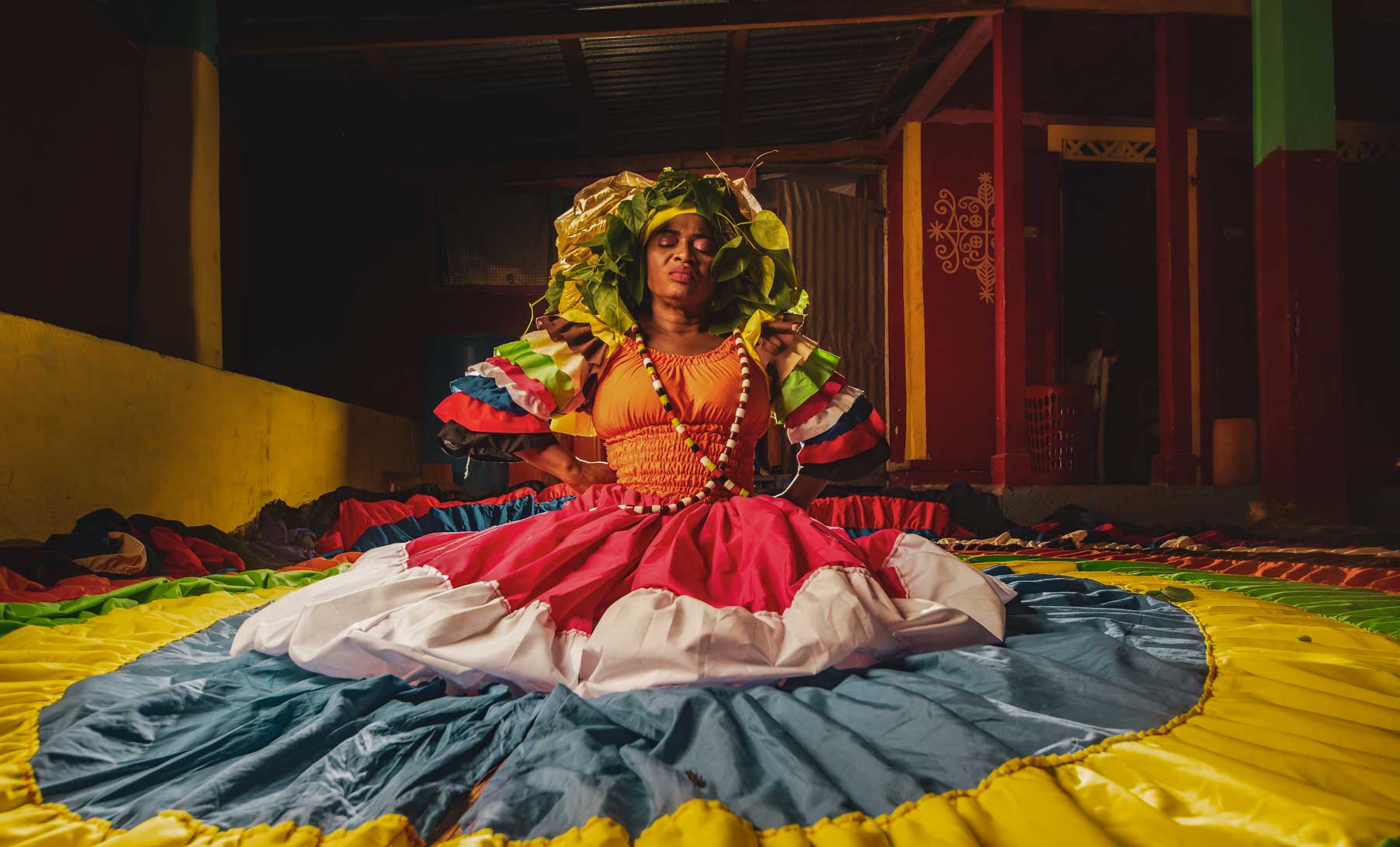
Photo: Verdy Verna
Haitian Vodou Revealed
When it comes to Haitian Vodou, what is fact, and what is fiction? Test your knowledge of the world’s most maligned spiritual tradition.
Vodou originated in the African kingdoms of Fon and Kongo as many as 6,000 years ago. In modern Haiti, this spiritual practice is a creolized version that incorporates Amerindian Taíno and Arawak deities, Medieval Catholic influences, and even Masonic rituals!
By and large, people associate Vodou* with evil, devil worship, and violent animal sacrifice. But many of its rituals (even those that include the sacrifice of live animals) focus on restoring peace and balance – in families, communities, and between the human realm and the realms of the lwa – the spirits.
Vodou religious leaders are respected figures in their communities, providing guidance, settling disputes, and providing medical care in the form of herbal healing. Priests – oungan – and priestesses – manbo – dedicate their lives to helping others and assisting them in serving their lwa. People who practice Vodou are known as vodouwizan, vodouisants (French), or in Haitian Kreyòl, sèvitè – “servants of the spirits”.
As Haitian nationals and the Haitian diaspora in Canada, the United States, and France become more open about their practice of Vodou, the truth about this enigmatic spiritual practice is slowly being revealed to the world. This is a story of how a spiritual tradition designed to heal and maintain balance was caught up in a case of mistaken identity, from which it is still recovering today.
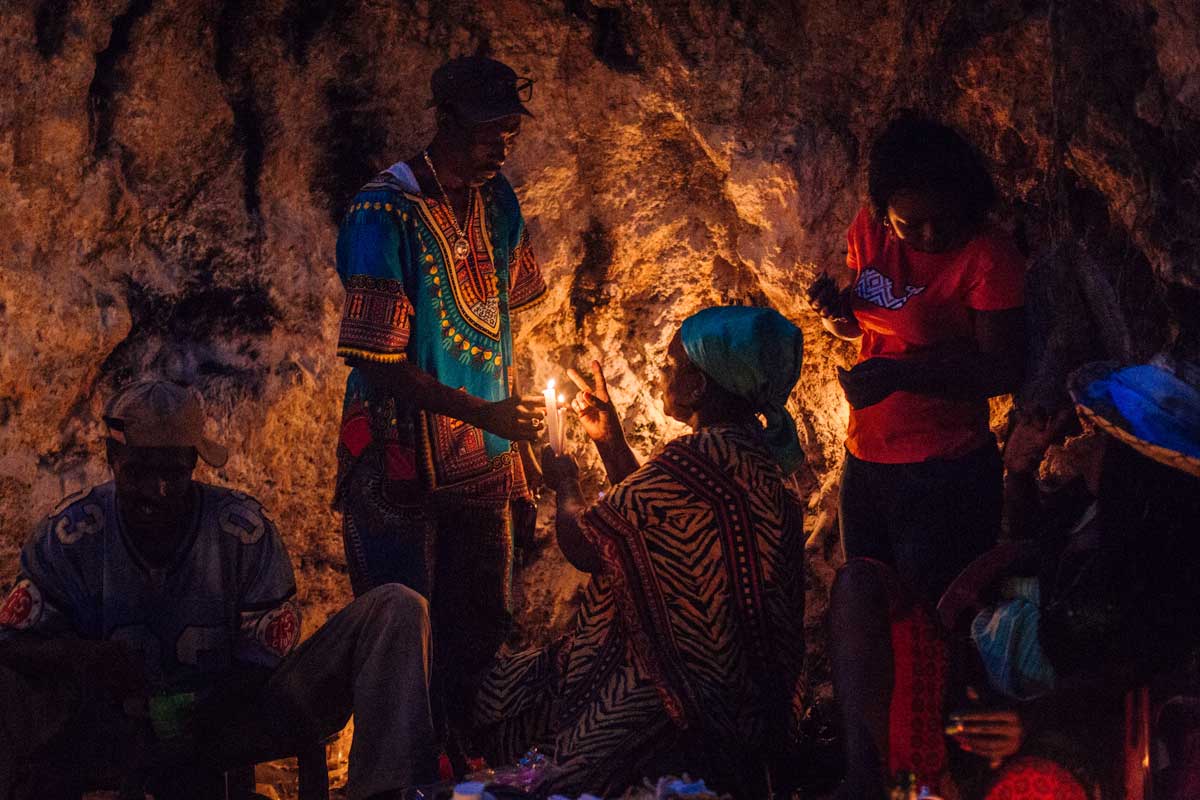
Photo: Pierre Michel Jean
Devil-worship or disinformation?
A 2011-12 exhibit at the Canadian Museum of Civilization suggests that Vodou was the target of a cultural disinformation campaign. Between 1915 and 1934, the United States Marine Corps occupied Haiti. During the occupation, Haiti became the backdrop for books and movies depicting Vodou as cruel, sinister, and bloody. Tracing media depictions of Haitian Vodou over time, the museum showed how anti-Vodou propaganda was deliberately spread to discredit anti-occupation forces. Movies like White Zombie, released in 1932, portrayed Vodou priests and others who resisted foreign occupation as bloodthirsty, deceptive, and downright evil.
Test your knowledge of Vodou
Now that we’ve set the record straight, it’s time to test your knowledge of this mysterious religion.

Photo: Emily Bauman / Amanacer
1. True or false: there are separate branches of Vodou.
Answer: True!
Vodou lwa are divided into several branches or “nations”: the most prominent are Petwo and Rada.
Since there are more than two branches of lwa, it’s difficult to define Petwo and Rada purely in opposition to each other, but they are certainly starkly different.
Some anthropologists have described the Rada as benevolent and the Petwo as malevolent, or the Rada as representing ‘insider’ forces while the Petwo represent ‘outsider’ forces.
Rada lwa, according to anthropologist Karen McCarthy Brown, are generally gentle, kind and mostly concerned with supporting the wellbeing of their adherents. Petwo lwa, on the other hand, are hot-tempered, even explosive – the rituals that call Petwo lwa involve intense drumming, whip-cracks, gasoline and even ignited gunpowder. Some anthropologists believe the Petwo lwa are indigenous to Haiti, not imported from Africa – generated either as creolizations of native Taíno or Arawak deities, or born out of the need to survive the harsh conditions and trauma that the enslaved vodouwizan had to endure.
We can illustrate this dichotomy with the two rival lwa, Erzulie Freda and Erzulie Dantò. Two aspects of the same female deity, Erzulie Freda is a Rada lwa, and Erzulie Dantò is a Petwo lwa. In the same way that a diamond has hundreds of facets, a Vodou spirit or lwa has seemingly unlimited sides. Practitioners understand that if the entire lwa – in its full power – were to manifest itself, it would be overpowering, so they choose to invoke only one facet at a time.
Erzulie Freda and Erzulie Dantò are each part of a whole, but are depicted in traditional Haitian folklore as starkly different. Erzulie Freda is depicted as a fair-skinned bourgeois city woman who enjoys wealth, luxury, and the finer things in life like perfumes, jewelry, and flowers. Her counterpart, Dantò, a fierce defender of children, women, and society’s rejects, is dark-skinned and proudly wears two distinct scars on her face. Whereas Freda might respond to a crisis by crying, Dantò responds by becoming enraged.
The vèvè Vodou symbol for each version of Erzulie contains a heart, but each is distinct. Erzulie Dantò’s cosmogram features a sword through a heart, indicating her power to enact vengeance, protect children, and fulfill the fiery side of love on behalf of the lwa.
Whether you attend a ceremony held for Erzulie Freda or Erzulie Dantò is as different as going to a gentle Quaker gathering for collective consciousness unity, or a Pentecostal prayer meeting calling on the Holy Spirit for vigorous and fiery healing.
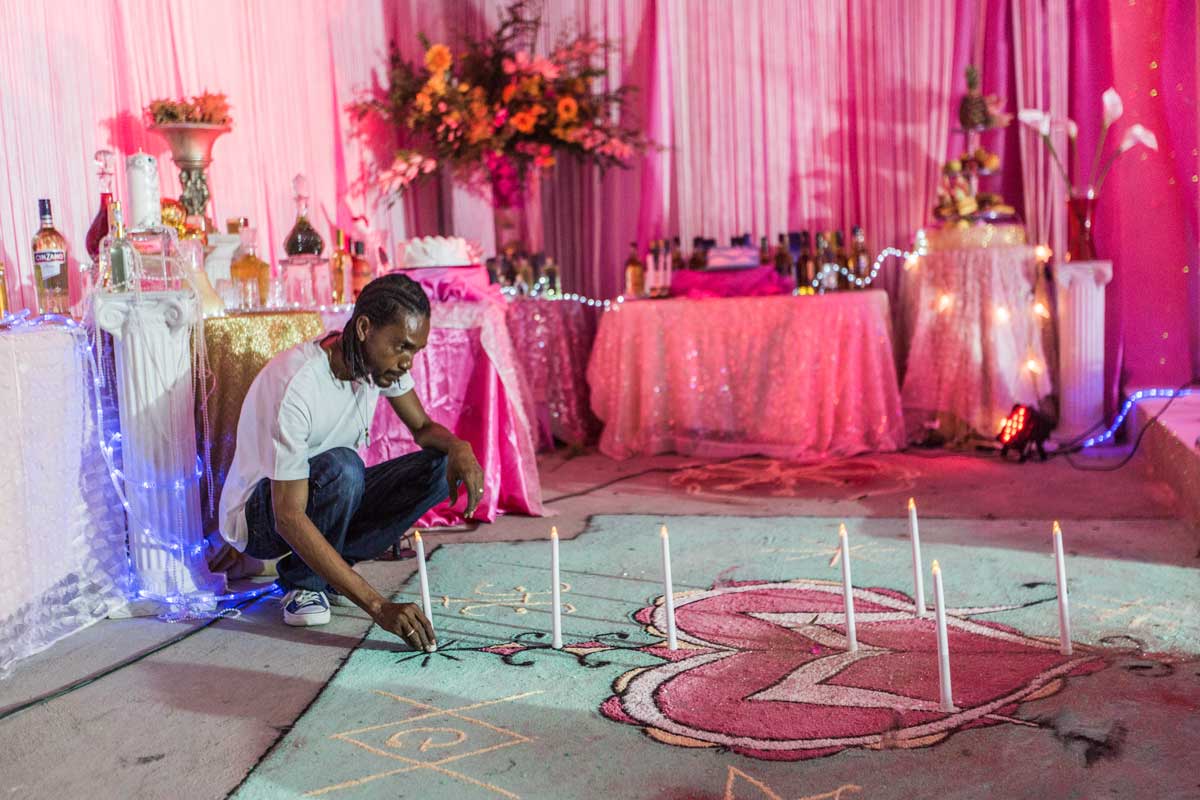
Photo: Pierre Michel Jean
2. True or false: Vodou is all sinister sorcery and black magic.
Answer: False!
There are two satellites of Vodou one might call secret societies. The dark practices of these secret societies were mistakenly called Voodoo by American officials in the early 1900s, causing confusion that persists to this day.
These two secret societies are Makaya and Bizango. They are what one may more accurately consider dark magic or sorcery; their practitioners use curses and incantations designed to cause harm. As opposed to Petwo and Rada Vodou, whose goals are to support and guide life, Makaya and Bizango employ practices harnessed against life.
How did these secret societies arrive in Haiti? It is said that Bizango started as a blend of West-African Bo and European necromancy brought to Hispaniola by colonizers. The story goes that African slaves brought to work sugar plantations were witness to their masters’ dark rituals on the plantations. This is when European knowledge would have been acquired, then combined with rituals from Africa to form a new syncretic practice.
Makaya, on the other hand, is believed to be a merging of Amerindian shapeshifting and other ritual secrets with the imported West-African Bo. The native inhabitants of the island were reputed to know the art of shapeshifting and of poisons, with rituals and practices designed to harm or protect individuals and communities.
Makaya places a stronger emphasis on shifting one’s corporeal form, and its lore includes stories of teleporting from one side of the island to another through secret portals revealed to the marooned slaves by the native Taíno. Some say that this is how revolutionaries were able to travel swiftly across the island and confound colonial armies.
When the US military occupation began in 1915, Western filmmakers exploited rumours about the darkest practices of Bizango and Makaya “voodoo” and through these caricatures, whether deliberately or not, vilified the country’s spiritual tradition.
In reality, love spells, curses, and rituals of revenge fall outside the realm of Vodou altogether. Curses, spells – and zombies – are instead the specialty of Bo in West-Africa and Bizango or Makaya in Haiti. In U.S. Vodou practice, they are categorized as “hoodoo” and should not be conflated with Vodou.
So if it’s not black magic, what is maji in Vodou?
When life gets chaotic and out of our control, westerners turn to psychologists, and Haitian vodouwizan turn to oungan and manbo. Everywhere on earth, for people of every faith, race and class, life can suddenly be thrown out of balance by sickness, professional failure, financial loss, family crisis or community conflict. At such times, vodouwizan ask the lwa to intervene and help the person in distress. This intervention is maji.
Practitioners of maji perform treatments to heal or protect those who consult them. In a dedicated room called a badji, the practitioner uses ritual to call in a lwa whose intervention is most appropriate for the given situation. The lwa may speak to the practitioner, or through the practitioner, possessing the practitioner’s body to investigate the situation for itself. The lwa decides on the appropriate course of action required to restore balance and shares this valuable information through the manbo or oungan.
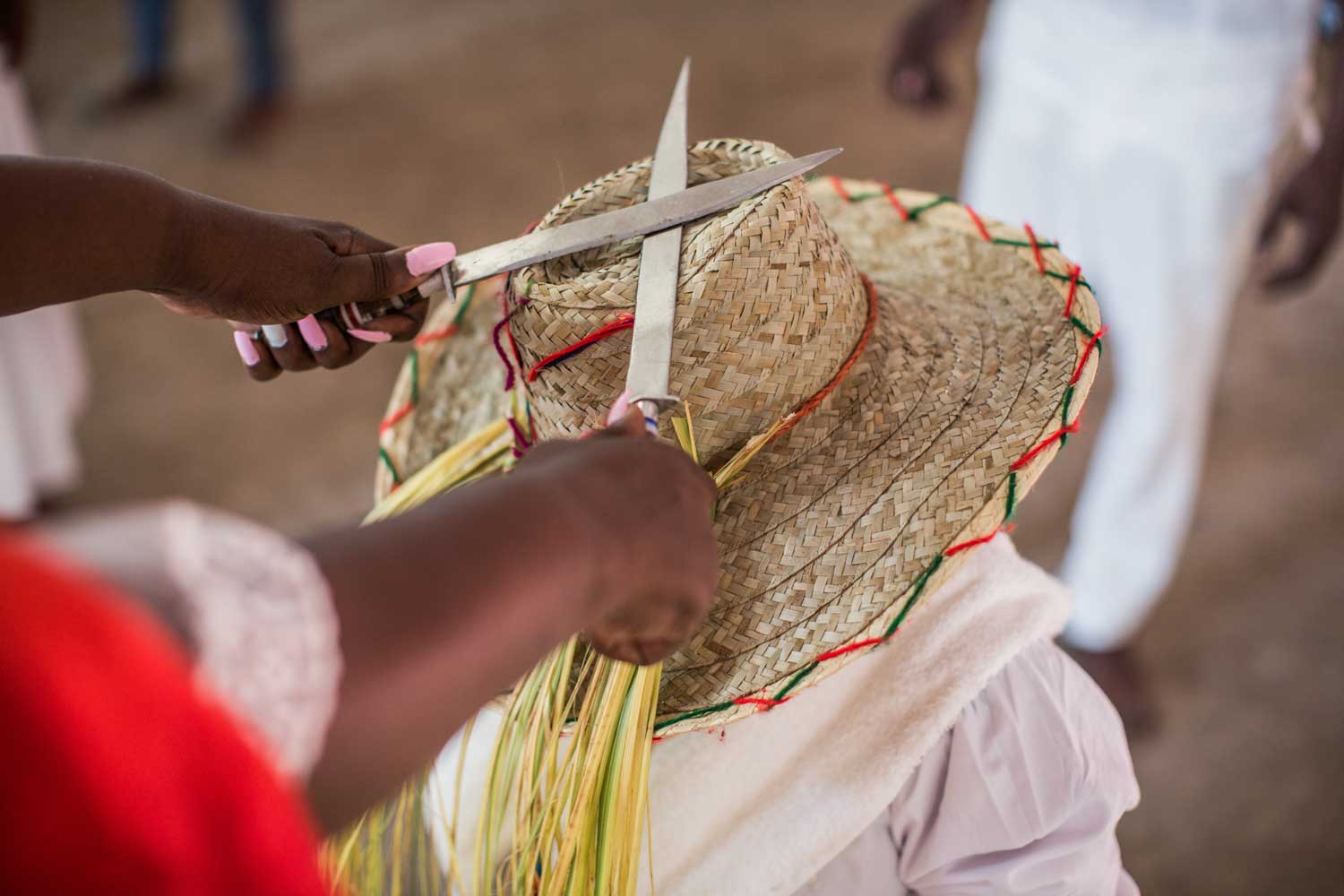
Photo: Pierre Michel Jean
3. True or false: voodoo dolls are real
Answer: True AND False
During the American occupation, books and films aimed at the general public propagated many of the fictions that continue to degrade Vodou by associating it with evil sorcery. One of the strongest fictions is the image of a voodoo doll pricked with pins to cause injury or suffering to an enemy.
Pricked with pins and full of evil powers, the primitive cloth doll has become the image most often associated with Vodou in the world’s collective imagination. This has nothing, however, to do with the real spiritual practice in Haiti.
In reality, dolls are occasionally used in the practice of Haitian Vodou, but not to cast spells! Placed near graves or hung from the branches of Kapok trees, these dolls convey messages sent by vodouwizan to the dead or to ancestors.
4. True or false: zombies are real
Answer: True!
Forget what you think you know about zombies. While Haitian zombies may not match their typical portrayal in popular media, they hold a very real place in the country’s cultural beliefs. There’s so much to explore about zombie fact and fiction that we’ve dedicated a separate article to it.
Learn all about Haitian zombies here.
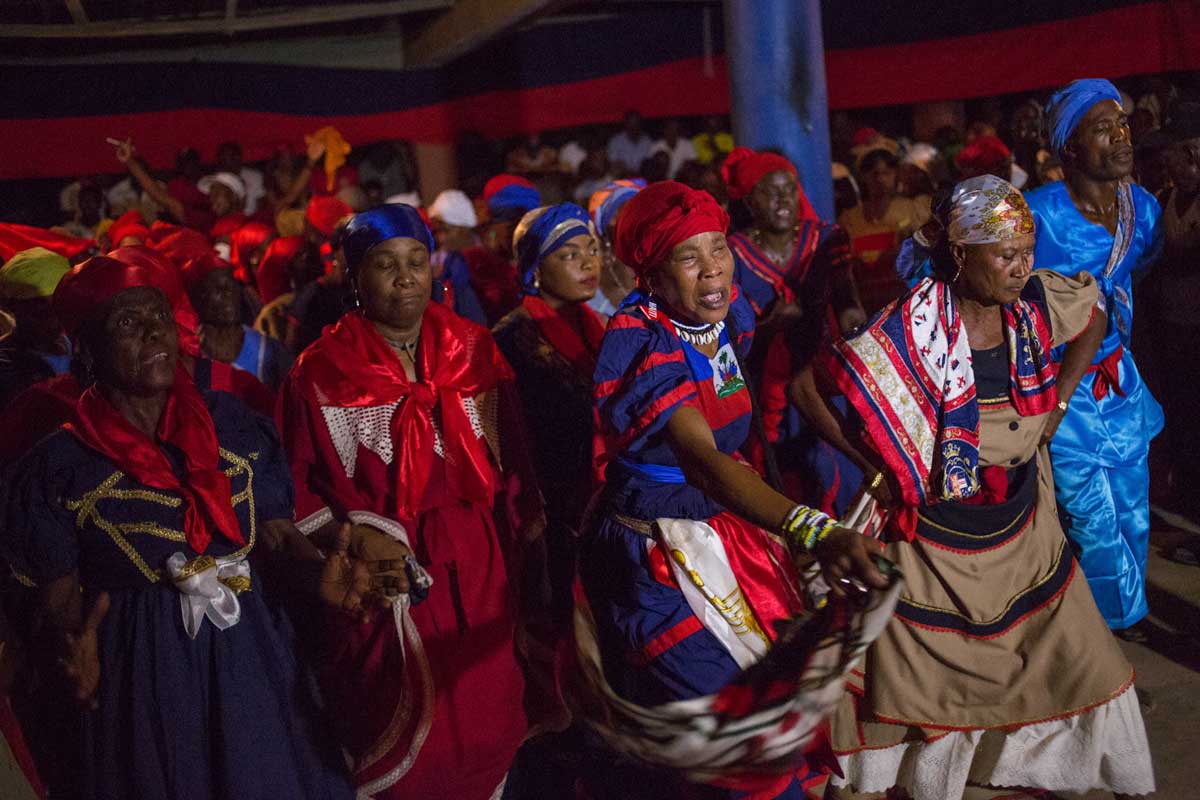
Photo: Pierre Michel Jean
5. True or false: vodou and Christianity first merged in the new world.
Answer: False!
Many of the slaves brought to Hispaniola from northern and central Africa between the 16th and 18th centuries practiced the African form of Vodou. Since the colony’s slave code required all slaves to convert to Christianity, Vodou dances were strictly forbidden, and slaves could not observe their religion openly. They found themselves borrowing many elements from Catholicism to disguise and thus maintain their spiritual practice.
Lwa were assigned the faces of corresponding Saints. For example, Saint Peter holds the keys to the kingdom of heaven and corresponds to Papa Legba, who in Vodou is the gatekeeper to the spirit world. This process, known as syncretization, is why visitors to Haiti can see paintings for sale of a figure who appears to be Mary Mother of Jesus with black skin, and not know that they are really looking at a portrayal of Erzulie Dantò.
What is even less known is that this syncretization began hundreds of years earlier, before the first captured slave was ever sold on Haiti’s shores.
Long before Christopher Columbus docked on the island of Hispaniola, Portuguese monks visited the kingdom of Kongo, from where much of Haitian Vodou originates. These early Christian missionaries arrived in the capital after a long journey, appearing before the Kongo chief and his queen. They wore the plain beige robes of the medieval Jesuit priesthood.
The priests brought with them ornate golden crosses and, with permission, set up shop as missionaries do. They began to learn the local language, communicated as best they could, and shared stories about the Christian Holy Trinity, the resurrection story of Jesus, and the work of the Holy Spirit. In historical letters written to Portugal’s king and queen, the missionaries recount how the Kongo high court was fascinated with the Jesuit’s religion and adopted certain stories into their own belief systems.
The cross and the story of Jesus’s death and resurrection was integrated into the system of traditional Vodou lwa spirits and ancestor worship in the Kongo, which was then taken to Haiti by 16th-century African slaves. The Christian cross became a symbol for the crossroads, which represents life-altering choices and steps along the spiritual path for followers of Vodou in both its African and Haitian expressions to this day.
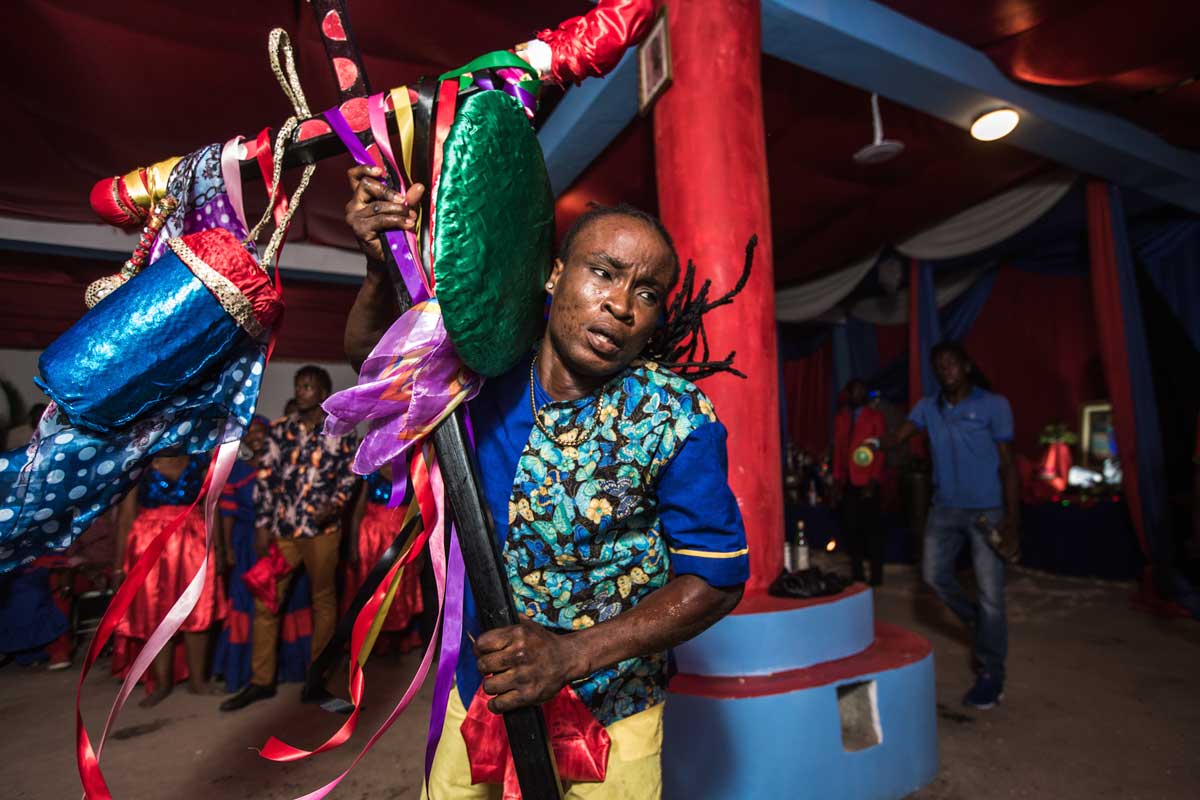
Photo: Pierre Michel Jean
6. True or false: it’s dangerous to attend a Vodou ceremony because you’ll get possessed.
Answer: False!
One of non-initiates’ greatest fears when it comes to Vodou is being possessed by spirits against their will. While possession does take place at Vodou ceremonies, there is little danger that a spectator will be spontaneously “ridden” by the lwa.
For a vodouwizan, being possessed is like momentarily disappearing in order to become the physical vessel for a lwa. The actions and words of the possessed are believed to be the loa expressing itself, addressing others, advising or consoling, encouraging or scolding, punishing or healing through the Vodouwizan.
For practitioners of Vodou, there is nothing strange or special about possession. It can happen at any moment, and can last anywhere from a few minutes to hours or even days.
If this sounds scary, it’s helpful to remember that an immense amount of training, initiation, not to mention financial resources and sacred planning go into holding a Vodou ceremony. People are looking for answers to real problems around financial ruin, broken relationships, and discord. Each ceremony is held with a specific purpose or intention, and it would not be accomplished if the possessed chwal (or “horse”) wasn’t up to the task of the full participation required of their role.
For the same reason, it is exceedingly unlikely that a spectator at a Vodou dans (ceremony) would spontaneously be possessed. In fact, it is extremely rare for a non-initiate to be invited to participate in a major way in an important Vodou ceremony.
Experience Vodou on your visit to Haiti
- Join the party on the Haitian Day of the Dead
- Get front-row tickets to Vodou rock and roots band RAM
- Visit a museum dedicated to Vodou
- Marvel at unreal art at Galerie Monin
- Follow the pilgrimage to Saut D’eau
- Attend a Vodou ceremony
Further reading
For an accessible, illuminating read about Vodou, see Boukman Eksperyans songstress Mimirose Beaubrun’s Nan Domi – An initiate’s journey into Haitian Vodou. Available in French and English.
For more about the vèvè cosmograms representing the lwa, see the fantastic illustrations and explanations found in a trilingual book by Milo Regaud, Ve-Ve Diagrammes Rituels du Voudou : Ritual Voodoo Diagrams : Blasones de los Vodu – Trilingual ed.Text in French, English, and Spanish.
Mama Lola: A Vodou Priestess in Brooklyn by anthropologist Karen McCarthy Brown. Released in 1991, this book is credited with making great strides toward the destigmatisation of Haitian Vodou.
Afro-Caribbean Religions: An Introduction to Their Historical, Cultural, and Sacred Traditions, by Nathaniel Samuel Murrell. Includes 40 pages on Haitian Vodou.
*A quick word about the different spellings of Vodou: some scholars still use the spelling “voodoo;” however, Haitian Vodou initiates and supportive academics prefer alternate spellings such as Vodou, Vodon, Vodun or Vodu.
Written by Emily Bauman.
Published June 2021
Explore Haiti’s Art & Culture

Paradise for your inbox
Your monthly ticket to Haiti awaits! Get first-hand travel tips, the latest news, and inspiring stories delivered straight to your inbox—no spam, just paradise.

